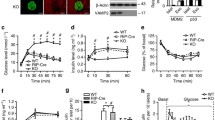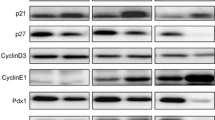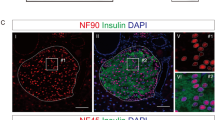Abstract
The apoptosis of β cells induced by hyperglycemia has been associated with p53 mobilization to mitochondria and p53 phosphorylation. Murine double minute 2 (Mdm2) induces the degradation of p53 and thereby protects cells from apoptosis. We studied the effect of glucose at high concentration on the ability of Mdm2 to ubiquitinate p53 and promote its degradation. RINm5F cells were grown in RPMI-1640 medium with 5 or 30 mM glucose for varying periods of time. After this treatment, the expression of Mdm2 was measured using real-time PCR. The phosphorylation of Mdm2 at Ser166, p53 at Ser15, and the kinases Akt and ATM were measured by Western blotting. The formation of the p53-Mdm2 complex and p53 ubiquitination was assessed by p53 immunoprecipitation and immunofluorescence. Our results showed that high glucose reduced Mdm2 mRNA expression and protein concentration and increased Mdm2 and Akt phosphorylation, albeit with slower kinetics for Akt. It also promoted p53-Mdm2 complex formation, whereas p53 ubiquitination was suppressed. Furthermore, phosphorylation of both p53 Ser15 and ATM was increased in the presence of 30 mM glucose. These data indicate that high concentration glucose decrease the mRNA expression and cytosolic concentration of Mdm2. However, although the increase in glucose promoted the phosphorylation of Mdm2, it also decreased p53 ubiquitination, thus avoiding p53 degradation. In hyperglycemic conditions, such as diabetes mellitus, the reduction of pancreatic β cells mass is favored by stabilization of p53 in association with low p53 ubiquitination and reduced expression of Mdm2.




Similar content being viewed by others
References
Efanova IB, Zaitsev SV, Zhivotovsky B, Köhler M, Efendić S, Orrenius S, Berggren PO (1998) Glucose and tolbutamide induce apoptosis in pancreatic β-Cells a process dependent on intracellular Ca2 + concentration. J Biol Chem 273:33501–33507
Donath MY, Gross DJ, Cerasi E, Kaiser N (1999) Hyperglycemia-induced -cell apoptosis in pancreatic islets of Psammomys obesus during development of diabetes. Diabetes 48:738–744
Butler AE, Janson J, Bonner-Weir S (2003) β-Cell deficit and increased β-cell apoptosis in humans with type 2 diabetes. Diabetes 52:102–110
Prentki M, Nolan CJ (2006) Islet Β cell failure in type 2 diabetes. J Clin Invest 116:1802–1812
Nishikawa T, Edelstein D, Du JX, Yamagishi S, Matsumura T, Kaneda Y, Yorek AM, Beebe D, Oates JP, Hemmes PH, Giardino I, Brownlee M (2000) Normalizing mitochondrial superoxide production blocks three pathways of hyperglycaemic damage. Nature 404:787–790
Kim W-H, Lee JW, Suh YH, Hong SH, Choi JS, Lim JH, Song JH, Gao B, Jung MH (2005) Exposure to chronic high glucose induces –β cell apoptosis through decreased interaction of glucokinase with mitochondria. Diabetes 54:2602–2611
Ortega-Camarillo C, Guzmán-Grenfell AM, García-Macedo R, Rosales-Torres AM, Ávalos-Rodríguez A, Duran-Reyes G, Medina-Navarro R, Cruz M, Díaz-Flores M, Kumate J (2006) Hyperglycemia induces apoptosis and p53 mobilization to mitochondria in RINm5F cells. Mol Cell Biochem 281:163–170
Flores-López LA, Díaz-Flores M, García-Macedo R, Ávalos-Rodríguez A, Vergara-Onofre M, Cruz M, Contreras-Ramos A, Konigsberg M, Ortega-Camarillo C (2013) High glucose induces mitochondrial p53 phosphorylation by p38 MAPK in pancreatic RINm5F cells. Mol Biol Rep 40:4947–4958
Speidel D, Helmbold H, Deppert W (2006) Dissection of transcriptional and non-transcriptional p53 activities in the response to genotoxic stress. Oncogene 25:940–953
Li M, Brooks CL, Wu-Baer F, Chen D, Baer R, Gu W (2003) Mono- versus polyubiquitination: differential control of p53 fate by Mdm2. Science 302:1972–1975
Lee JT, Gu W (2010) The multiple levels of regulation by p53 ubiquitination. Cell Death Diff 17:86–92
Wu X, Bayle JH, Olson D, Levine AJ (1993) The p53-mdm-2 autoregulatory feedback loop. Genes Dev 7:1126–1132
Deisenroth C, Zhang Y (2011) The ribosomal protein-Mdm2-p53 pathway and energy metabolism: bridging the gap between feast and famine. Genes Cancer 2:392–403
Meek DW, Knippschild U (2003) Posttranslational modification of MDM2. Mol Cancer Res 1:1026–1071
Maya R, Balass M, Kim S-T, Shkedy D, Leal J-FM, Shifman O, Moas M, Buschmann T, Ze Ronai, Shiloh Y, Kastan MB, Katzir E, Oren M (2001) ATM-dependent phosphorylation of Mdm2 on serine 395: role in p53 activation by DNA damage. Gen Dev 15:1067–1077
Dai C-L, Shi J, Chen Y, Iqbal K, Liu F, Gong C-X (2012) Inhibition of protein synthesis alters protein degradation through activation of protein kinase B (AKT). J Biol Chem 288:23875–23883
Ji H, Ding Z, Hawke D, Xing D, Jiang B-H, Mills GB, Lu Z (2012) AKT-dependent phosphorylation of Niban regulates nucleophosmin- and MDM2-mediated p53 stability and cell apoptosis. EMBO Rep 13:554–560
Ogawara Y, Kishishita S, Obata T, Isazawa Y, Suzuki T, Tanaka K, Masuyama N, Gotoh Y (2002) Akt enhances Mdm2-mediated ubiquitination and degradation of p53. J Biol Chem 277:21843–21850
Mayo LD, Donner DB (2001) A phosphatidylinositol 3-kinase/Akt pathway promotes translocation of Mdm2 from the cytoplasm to the nucleus. Proc Natl Acad Sci USA 98:11598–11603
Lowry OH, Rosebrough NJ, Farr AL, Randall RJ (1951) Protein measurement with the folin phenol reagent. J Biol Chem 193:265–275
Lablanche S, Cottet-Rousselle C, Lamarche F, Benhamou P-Y, Halimi S, Leverve X, Fontaine E (2011) Protection of pancreatic INS-1 β-cells from glucose- and fructose-induced cell death by inhibiting mitochondrial permeability transition with cyclosporin A or metformin. Cell Death Dis 2(3):e134. doi:10.1038/cddis.2011.15
Hinault C, Kawamori D, Liew CW, Maier B, Hu J, Keller SR, Mirmira RG, Scrable H, Kulkarni RN (2011) D40 isoform of p53 controls β-cell proliferation and glucose homeostasis in mice. Diabetes 60:1210–1222
Kon N, Zhong J, Qiang L, Accili D, Gu W (2012) Inactivation of arf-bp1 induces p53 activation and diabetic phenotypes in mice. J Biol Chem 287:5102–5111
Jonas J-C, Laybutt DR, Steil GM, Trivedi N, Pertusa JG, Casteele MVd, Weir GC, Henquin J-C (2001) High Glucose stimulates early response gene c-Myc expression in rat pancreatic β cells. J Biol Chem 276:35375–35381
Men X, Peng L, Wang H, Zhang W, Xu S, Fang Q, Liu H, Yang W, Lou J (2013) Involvement of the Ca2 + -responsive transactivator in high glucose-induced β-cell apoptosis. J Endocrinol 216:231–243. doi:10.1530/JOE-12-0286
Robertson RP, Harmon J, Tran PO, Tanaka Y, Takahashi H (2003) Glucose toxicity in B-cells: type 2 diabetes, good radicals gone bad, and the glutathione connection. Diabetes 52:581–587
Kruse J-P, Gu W (2009) Modes of p53 regulation. Cell 137:609–622
Tornovsky-Babeay S, Dadon D, Ziv O, Tzipilevich E, Kadosh T, Haroush RS-B, Hija A, Stolovich-Rain M, Furth-Lavi J, Granot Z, Porat S, Philipson LH, Herold KC, Bhatti TR, Stanley C, Ashcroft FM, Veld P It, Saada A, Magnuson MA, Glaseremail B, Doremail Y (2014) Type 2 diabetes and congenital hyperinsulinism cause DNA double-strand breaks and p53 activity in β-cells. Cell Metab 19:109–121
Feng J, Tamaskovic R, Yang Z, Brazil DP, Merlo A, Hess D, Hemmings BA (2004) Stabilization of Mdm2 via decreased ubiquitination is mediated by protein kinase B/Akt-dependent phosphorylation. J Biol Chem 279:35510–35517
Malmlöf M, Roudier E, Högberg J, Stenius U (2007) MEK-ERK mediated phosphorylation of Mdm2 at ser-166 in hepatocytes. Mdm2 is activated in response to inhibited Akt signalling. J Biol Chem 282:2288–2296
Zhou BP, Liao Y, Xia W, Zou Y, Spohn B, Hung M-C (2001) HER-2/neu induces p53 ubiquitination via Akt-mediated MDM2 phosphorylation. Nature Cell Biol 3:973–982
Yano T, Liu Z, Donovan J, Thomas MK, Habener JF (2007) Stromal cell-derived factor-1 (SDF-1)/chemokine (C-X-C motif) receptor 4 (CXCR4) axis activation induces intra-islet glucagon-like peptide-1 (GLP-1) production and enhances beta cell survival. Diabetes 56:2946–2957
Tuttle RL, Gill NS, Pugh W, Lee JP, Koeberlein B, Furth EE, Polonsky KS, Naji A, Birnbaum MJ (2001) Regulation of pancreatic beta-cell growth and survival by the serine/threonine protein kinase Akt1/PKB alpha. Nat Med 7:1133–1137
Morimoto Y, Bando YK, Shigeta T, Monji A, Murohara T (2001) Atorvastin prevents ischemic limb loss in type 2 diabetes: role of p53. J Atherosclerosis Thromb 18:200–208
Cheng Q, Cross B, Li B, Chen L, Li Z, Chen J (2011) Regulation of MDM2 E3 ligase activity by phosphorylation after DNA damage. Mol Cell Biol 31:4951–4963
Cheng Q, song T, Chen L, Chen J (2014) Auto-activation of the MDM2 E3 ligase by intra-molecular interaction. Mol Cell Biol. doi:10.1128/MCB.00246-14
Cheng Q, Chen L, Li Z, Lane WS, Chen J (2009) ATM activates p53 by regulating MDM2 oligomerization and E3 processivity. EMBO J 28:3857–3867
Lavin MF, Gueven N (2006) The complexity of p53 stabilization and activation. Cell Death Diff 13:941–950
Krauss S, Zhang C-Y, Scorrano L, Dalgaard LT, St-Pierre J, Grey ST, Lowell BB (2003) Superoxide-mediate activation of uncoupling protein 2 causes pancreatic Β cell dysfunction. J Clin Invest 112:1831–1842
Bhattacharya S, Chaum E, Johnson DA, Johnson LR (2012) Age-related susceptibility to apoptosis in human retinal pigment epithelial cells is triggered by disruption of p53-Mdm2 association. Invest Ophthalmol Vis Sci 53:8350–8366
Moll UM, Petrenko O (2003) The MDM2-p53 interaction. Mol Cancer Res 1:1001–1008
Saito SI, Yamaguchi H, Higashimoto Y, Chao C, Xu Y, Fornace AJ Jr, Appella E, Anderson CW (2003) Phosphorylation site interdependence of human p53 post-translational modifications in response to stress. J Biol Chem 278:37536–37544
Acknowledgements
This work was sponsored by the Fund for Research in Health (Fondo de Investigación en Salud, FIS), Mexican Social Security Institute (Instituto Mexicano del Seguro Social, IMSS) (FIS/IMSS/PROT/G11 968 2012). We extend our thanks to the IMSS Foundation A.C. and the Rio Arronte Foundation I.A.P. for their support in equipping the Medical Research Unit in Biochemistry. We would also like to thank the National Council for Science and Technology (CONACYT) and the Coordination for Research in Health, IMSS (R Barzalobre-Geronimo, scholarship).
Conflict of interest
The authors declare no conflict of interest.
Author information
Authors and Affiliations
Corresponding author
Rights and permissions
About this article
Cite this article
Raúl, BG., Antonio, FL.L., Arturo, BG.L. et al. Hyperglycemia promotes p53-Mdm2 interaction but reduces p53 ubiquitination in RINm5F cells. Mol Cell Biochem 405, 257–264 (2015). https://doi.org/10.1007/s11010-015-2416-0
Received:
Accepted:
Published:
Issue Date:
DOI: https://doi.org/10.1007/s11010-015-2416-0




